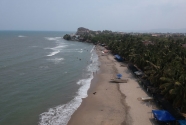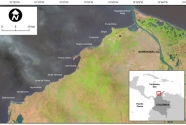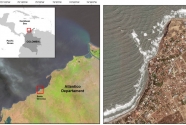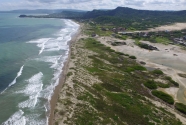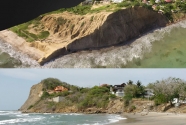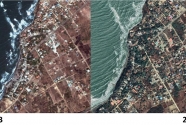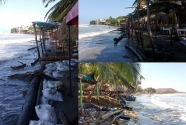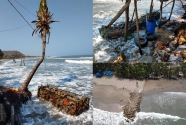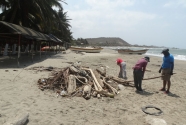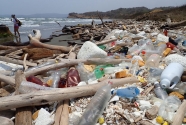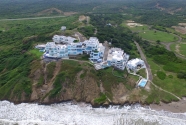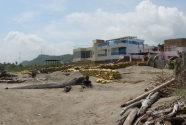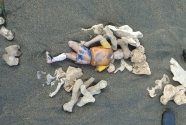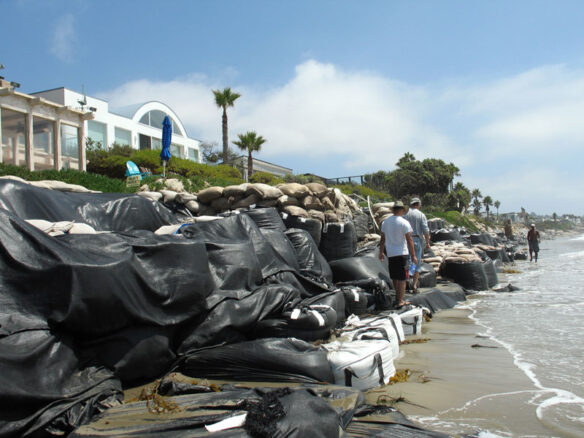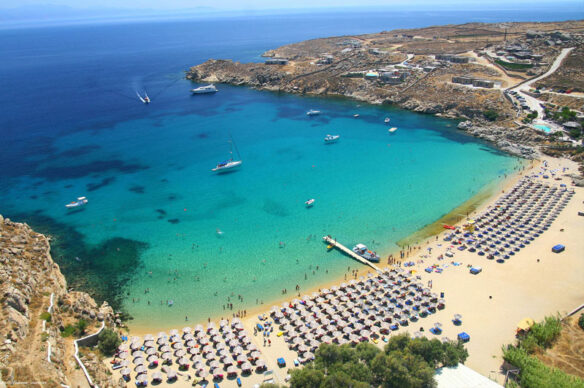Nelson Rangel-Buitrago, Adriana Gracia, Grupo de Geología, Geofísica y Procesos Marino-Costeros, Universidad del Atlántico Barranquilla, Atlántico, Colombia, and William J. Neal Department of Geology, Grand Valley State University, Allendale, Michigan.
Recall the proverbial “canary in the coal mine” – miners carried the bird in a cage to measure air quality; dead bird, get out of the mine! Santa Veronica Beach, Colombia, is a model for the “canary in coastal development.” The community of Santa Veronica owes its existence to the recreational beach (Figure 1), and the economies of the adjacent communities of Santa Veronica Cajacopi and Salinas del Rey are tied to this beach tourism (Juan de Acosta Municipality). Santa Veronica is one of numerous recreational beach developments along Colombia’s Caribbean Coast (Figure 2); most sharing a similar history of shoreline retreat, perceived as shoreline erosion, and the attempt to hold the shoreline in place through the use of shore-hardening structures.
While the authors were conducting a regional study of Colombia’s Caribbean Coast, they revisited Santa Veronica beach to conduct drone flights (Figure 3). These aerial views, as well as ground level observations on the shore, revealed problems that are at the core of an on-going controversy over the conception of shoreline erosion, and how the local vendors were responding to their beach-front losses of kiosks and other structures. On 15 March 2019 the headline of the El Heraldo (Baranquilla city newspaper) was “Coastal Erosion also Hits Juan de Acosta” (English translation) with a photo of locally-made gabions forming a short wall, already swamped by waves. And on 1 April the El Tiempo news headline was “Santa Verónica fights so the sea does not swallow its beaches” (~English translation). How did it come to this?
Natural Setting
The Caribbean coast of Colombia has a rich geological, biological and cultural diversity that is reflected in a unique coastal zone extending from Venezuela to the Panama border. This coast is the first region that revealed the beauty of Colombia to the world with the golden walls of old Cartagena, the white sandy beaches of the Rosario Islands, and the green maze of Tayrona National Park (see Coastal Care, Beach of the Month, 2017-09/10). In the central part of this coast is the Atlantico Department shore, a 72 km long reach that lies predominantly in a NE–SW orientation with some sectors oriented E-W (Figure 2). This complex coastline’s geomorphology was determined by tectonic processes, landward surface erosion, and oceanographic processes, resulting in a shoreline of sandy beaches, sand spits, dunes, rocky coasts, lagoons, and some mangrove swamps (Rangel-Buitrago et al., 2018).
“Santa Veronica is one of numerous recreational beach developments along Colombia’s Caribbean Coast; most sharing a similar history of shoreline retreat… “
— N.Rangel-Buitrago, A. Gracia & W. Neal
The Department’s coastline is a developing area with 1,378,800 inhabitants (Gracia et al., 2018), representing close to 4% of Colombia’s total population, and located primarily in Barranquilla, the largest and most populated urban concentration on Colombia’s Caribbean coast. The region’s coast currently is an emerging tourist destination for both Colombians and international visitors. The attractive landscape, good weather conditions, and the increased capacity for the practice of adventure sports are major attractors for this area.
Santa Veronica is part of this semi-arid tropical environment (mean temperatures of <28ºC and maximum precipitation values of 2,500 mm/yr), and coastal amenities make the village beach a prime attraction for tourism development (Rangel-Buitrago et al., 2013). But this development apparently has overlooked some other aspects of the environment and climate that offset the ‘paradise’ of Sand-Sea-Sun attractors. In particular are wave energy, especially associated with storms, the sensitivity of the beach to its sediment supply, and how these relate to the gradual sea-level rise — all now being expressed in the landward migration of the beach.
Santa Veronica Village has long been a beach-tourism hot spot, first for locals but now tourists from a broader spectrum. The beach and community encompasses an area of 3.8 km2, with 17,925 inhabitants. Specifically, the Santa Veronica coastal zone is a 1.2 km length shoreline segment composed by 650 m of beach and 550m of cliffed coast (Figure 3). This beach is part of a shoreline reach, including adjacent communities, that forms a shallow pocket between the shadow of Cerro Furu at the northeast end to Punta de Piedra at the southwestern extremity.
Seasonal variations consist of two rainy periods (April-May and October-November) and two dry periods (December-March and July-September). Winds have average velocity values lower than 13 m/s. The larger wave-generating, higher-velocity winds are those blowing from the NE during the dry season. Lower velocity values are observed between September and November when winds blow from the East (Anfuso et al., 2015). The average significant wave height is 1.5 m and peak period average is 7.5 s. From November to July, the wave system along the area is dominated by NE swells; while for the remainder of the time, waves from NW, WSW, and even SW occur (Gracia et al., 2018). Tides are mixed semi-diurnal, with maximum amplitudes of 65 cm typical of a micro-tidal environment (Rangel-Buitrago et al., 2017).
Longshore sand drift has a dominant south-westward component, and this pattern is reflected in the groin-effect discussed below, as well as the greater abundance of sand along the SW part of the reach where sand dunes have formed (Figure 4). A minor reversal in the drift pattern, back to the northeast, occurs during rainy periods when southerly winds prevail in some areas, and set up short, high-frequency waves capable of generating significant sediment transport along sandy beaches (Figures 3 and 5). The headland and associated shallow-submerged bedrock ridge at the NE end of Santa Veronica beach creates a wave-refraction pattern that favors beach formation beyond that point (Figure 6).
A small portion of the beach sediment supply comes from the erosion of Tertiary sandstones that outcrop in these headlands (Figure 5). However, rivers are the ultimate major sand-sediment source to Santa Veronica beach, but this sand’s immediate availability is strongly controlled by the seasonal wave regimens that influence the strength and direction of long-shore drift. This supply of coarse terrigenous sediments comes mainly from the distant, large Magdalena River and three small distributaries which drain the Santa Veronica area. Historically, after the emplacement of the Magdalena River jetties, the old delta broke up and large sand bodies moved SW along the coast, sometimes coming on-shore to form or nourish sand beaches. However, these occurrences were temporary, and the resulting beaches lost their sand sources.
Brief History
Based on the newspaper interviews with locals, Santa Veronica originated in the mid-20th century, and reminiscences older inhabitants indicate that the beach was considerably wider in those early days. Stories of patron saint activities on the beach and playing football (soccer) on a wide beach area that is now under water. That wide-beach scenario began to change in 1988 with the passage of Hurricane El Joan. Cero Furu began to erode, taking away some of its protection of the beach in its shadow, and the beach also began to retreat. The apparent response to that impact was the construction of the large groin which, again as a local put it, precipitated an added erosion problem, recognizing that the groin blocked the down-drift sediment supply (“there is no beach because there is no sediment” – El Tiempo, 1 April 2019). After the emplacement of the groin, the responsibility of battling the shoreline retreat fell to the property owners, and again the interviewees noted that they’ve been trying to hold back the shoreline for at least 20 years. In this same time span Santa Veronica has experienced a population growth of 24% (Figure 7), accompanied by development crowding the shore with a corresponding loss of habitat (coastal squeeze).
Wrong Responses
Every year seasonal changes to the beach profile, although natural, are a severe problem to Santa Veronica inhabitants. Because there is no room to accommodate the shoreline advance, the kiosks and other buildings of the coastal squeeze are threatened by erosion or flooding (Figure 8). These seasonal and regular changes produce beach narrowing and inundation, deterioration of scenic quality, and loss financial investments resulting in seasonal construction of hard-protection structures that basically have little or no functionality, and ultimately contribute to both more beach loss and wasted finances. This squeeze of beach and the associated line of losing structures has become an obstacle hindering the economic growth of the village.
Currently, Santa Veronica beach only works on an ‘action-reaction or post-disaster’ basis, i.e., management initiatives are triggered each year by emergencies and not risk prevention. Every year history repeats itself:‘protective’ structures are built or installed in response to local stakeholder pressure when properties are exposed to destruction, without carrying out required environmental impact assessment or preliminary potential risk and collateral-effects evaluations.
The ‘urgent apparent coastal erosion solutions’ (gabions, sand bags, and litter used to construct walls and groins) are emplaced in order to quickly reduce the immediate perceived erosion process impact (Figure 9). Unfortunately, every year the clear lesson is that these ‘fast’ coastal defense structures are useless. So annually the next step is to petition for government help. In 2019 the immediate help came through the township Mayor’s office with a few thousand dollars’ worth of materials (e.g., stones and wire mesh) for the locals to build gabions, and repeat the folly. On a grander scale, regional government has proposals on the table including building a sand berm, that suspiciously sounds like they will rob sand from other beaches or dunes where ‘there is no erosion problem,’ or build as many as 11 additional groins (presumably larger than those built by the locals). In response to this latter proposal at least one old-timer had the wisdom to respond ‘…tourists do not want to come to look at stones but to contemplate the sea and bathe…’ (El Tiempo, 1 April 2019).
What else could go wrong? Litter
Santa Veronica beach is plagued by another negative aspect of Colombia’s Caribbean Coast – litter, both natural and man-made. The natural litter is drift wood – tons, and tons of driftwood – logs, branches, stumps with roots, covering beaches. Most of these tree remains are believed to have come from the Magdalena River, and probably have made more than a few stops along beaches on their way to the Southwest. In addition, there is man-made lumber adding to the wood volume, and large amounts of refuse dominated by plastics, but including a wide range of materials (e.g., metal, glass, processed wood, and rubber, among others – Gracia et al., 2018). These man-made materials come from two main sources – the long-shore drift and the trash left behind by beach users. The locals clean up the Santa Veronica beach, but untended beaches in adjacent areas commonly have lots of beach litter (Figures 10 and 11). We are now coming to realize that there is another aspect of beach litter that has a negative side. Encrusting marine organisms, always in search of hard surfaces for attachment, are now commonly found on beach litter (Figure 12). And some of these organisms can travel very long distances on the flotsam, allowing alien species to invade local marine habitats (Gracia et al., 2018).
Santa Veronica’s Lessons
In Santa Veronica’s relatively short history, those who built their homes and businesses close to the beach probably thought in terms of the shoreline being static. Old timers have had the life experience of discovering that the shoreline is dynamic, and that they are ever closer to the beach and its associated storm waves and inundation. Those who had property threatened or lost, responded in a common way, doing what seemed logical – solidify the shoreline by building walls and groins. Such empirical construction of seawalls and groins (whether from strong materials such as rip-rap, or weak construction such as gabions and sandbags) is a common practice along the entire reach of the Caribbean Coast of Colombia. Unfortunately, a significant percentage of people do not know the function of these structures and their negative impacts, especially when constructed with limited design information or knowledge of their confirmed negative impacts. In many instances, people with no knowledge regarding the causes of erosion, try to resolve the problem intuitively. Usually, coastal inhabitants collect stones from nearby quarries, produce low-cost concrete blocks, use concrete remains, tires and in some cases litter to build such structures to stop the perceived erosion.
“The managed/planned retreat option seems an inevitable solution and probably the most appropriate solution for the human settlement at Santa Veronica as well as much of Colombia’s coast… “
— N.Rangel-Buitrago, A. Gracia & W. Neal
Now the village is caught in the squeeze, and faces several unanticipated challenges from the impacts of increased regional population such as the pressure of increased development in the coastal zone (more beach users, more litter and pollution) to the impacts of climate change in terms sea-level rise and possibly increased storminess.
The managed/planned retreat option seems an inevitable solution and probably the most appropriate solution for the human settlement at Santa Veronica as well as much of Colombia’s coast. Managed/planned retreat has the primary objective of reducing population, property, and infrastructure at risk through the planned withdrawal from coastal hazard zones, including dynamic or erosion-prone areas (Neal et al., 2018 and Rangel-Buitrago and Neal, 2018).
Specific to Santa Veronica Beach, a managed retreat approach will help to move existing and proposed tourism development of most sensitive areas out of harms’ way. Along the entire reach, this approach may include managed realignment where shore-protection structures can be removed to allow the natural coastal environment to be re-established (i.e., the old big groin). Here the management approach must be based on the simple philosophy to get out, avoid damage, and recognize that the coastal zone dynamics should dictate the type of management employed: do not build/rebuild over the same shoreline.
The lesson from the Santa Veronica canary is that coastal management demands techniques, knowledge, equipment and institutional instruments to minimize or avoid coastal erosion, and if that is not possible then to reduce the impacts. The management should be optimally beneficial in reducing both the vulnerability of the coast or in reducing the effects of coastal natural changes or coastal erosion. Under current and projected future climate change developments, any management strategies should allow coastal communities to minimize their detrimental impacts on natural ecosystems while maximizing the benefits of the latter. Introducing new management strategies for a developed community such as Santa Veronica is difficult but not impossible, and there are numerous communities where development has not reached this stage that can benefit from the bad experiences of others. One has only to look at the shores of the adjacent communities within Juan de Acosta to see they have a chance to establish strong management goals. Yet the old patterns are already repeating themselves (Figures 14 and 15). Are we at a tipping point (Figure 16)?
Figure Captions
- Figure 1. NE Santa Veronica’s wider beach segment on a quiet day. The local economy is sand-sea-sun based, but the beach is narrowing. Note the dry-beach width narrowing toward the beach-less headland. The storm-wave breaker line is into the trees, flooding kiosks and business stands.
- Figure 2. Santa Veronica is about 35 km SW of the mouth of the Magdalena River. The recurved coastal segments are characterized by beaches between headlands, or barrier beaches fronting lagoon, and beaches associated with spits.
- Figure 3. Santa Veronica squeezes against a landward retreating shoreline, and the natural beach depends on interaction between ocean and landforms. Note the refracted wave pattern around the eroding headland, favoring some sand accumulation at the NE end of the beach. The line of breakers almost perpendicular to the shore is due to a shallow ridge of bedrock.
- Figure 4. Sand dunes at the SW end of this shoreline reach, fronting Salinas del Rey, reflect the SW trend of the longshore drift, and increased sand supply sufficient for dune formation.
- Figure 5. The predominant longshore drift to the SW is reflected by the pattern of sand trapping up-drift of the groin. Note the beach narrowing on the right of the groin, and its position farther landward, reflecting sand starvation on the down-drift side of the groin.
- Figure 6. The headland of outcropping Tertiary age sediments is a local source for some of the beach sand, although the ultimate source of beach sand here is from Magdalena River sediment input and longshore drift. Note the beach is narrow to absent around the headland, and in the lower photo one can see slabs of concrete, probably from earlier failed seawalls. Coarse debris dumped on the shore bank offers little protection from storm wave erosion.
- Figure 7. Comparison of the Santa Veronica development from 2003 to 2019. Note the large increase in housing. Shoreline changes are more difficult to discern as the vegetation line obscures the position of the back of the beach. One suspects that the wet-beach line has moved landward, while the kiosks and small buildings have been constructed closer to the sea – the coastal ‘squeeze’.
- Figure 8. The response to the landward migration of the beach has been individualistic, trying to hold the shoreline in place with whatever materials were available. Building walls or small groins with driftwood, sand bags, tires, and rock debris, resulting in a trashed beach, and still losing ground to the sea.
- Figure 9. More recently, with some minor assistance (loads of rock, wire baskets, and bags to fill), the same small-scale attempts to hold back the sea with gabions and sand bags will continue to fail. Gabions are a poor choice of construction material for seawalls and groins for several reasons. Note here that there is no top on the gabion wire basket. Storm waves will force the rocks out of the basket, littering the beach with sharp, angular stones that will not be welcomed by beach users. Sea water and wave/sediment abrasion will also result in failure of the gabion, which clearly has already been flanked by waves rendering it useless as a ‘protective’ measure. And size of structure doesn’t preclude failure. Note in the lower right photo that the large groin has been a significant contributor to down-drift erosion. No dry beach exists to the right of the groin. Why would property owners want additional structures of this sort? When their beach is gone, the tourists will be too.
- Figure 10. Santa Veronica beach is littered with both natural flotsam (wood) and trash, either arriving as flotsam or left behind by beach users. Locals clean the beach daily, piling the litter to be hauled away. However, sometimes wave run-up scatters the litter again before removal.
- Figure 11. Driftwood is abundant on many Colombian beaches, coming in part from local erosion, but mostly from the Magdalena River. Santa Veronica Cajacopi beach is covered with logs and branches that may give a slight natural protection to the beach by trapping sand, but in storms, these logs can become battering rams. In addition to limiting access by beach users, the maze of wood debris traps the abundant man-made litter from the longshore drift. Clearly, this litter is dominated by plastic, but larger items are common.
- Figure 12. Marine organisms attach to both man-made and natural flotsam. Here on Santa Veronica Cajacopi beach bryozoans are attached to a tree limb, and bivalves attached to a piece of rubber. Litter has become a transport mechanism for alien species.
- Figure 13. Newer construction south of Santa Veronica beach has ignored the lessons of the older village – don’t build next to the sea. Such buildings are not only threatened by wave erosion of the toe of the cliff, but also slumps and landslides due to over-steepened slope, ground-water seepage, and loading by the buildings and swimming pool.
- Figure 14. Another example lessons ignored and a house built too close to the back of the beach and threatened by storm-surge and wave attack. The sand-bag walls and driftwood fences will be of little protection in a big storm.
- Figure 15. This aerial view in the Salinas del Rey area is evidence of where the home owners want the beach line to be vs. where Nature will put the beach line. Note the houses in the foreground are fronted by walls with the back beach against the wall (sand over the wall in storms), but in the far back-ground note that the position of the beach is past the wall line, even with the houses, where it has not been restricted.
- Figure 16. A brief message in beach art.
References
- Anfuso, G., Rangel-Buitrago, N., Correa, I., 2015. Evolution of sandspits along the Caribbean Coast of Colombia: natural and human influences. In: Randazzo, G., Jackson, D., Cooper, J.A. (Eds.). Sand and Gravel Spits. Springer, New York, pp. 1-21.
- El Heraldo (Eliana Avendaño), 2019, Erosión costera también golpea a Juan de Acosta.
- El Tiempo (Leonardo Herrera Delgans), 2019, Santa Verónica lucha para que el mar no se trague sus playas.
- Gracia, A., Rangel-Buitrago, N., Florez, P., 2018. Beach litter and woody-debris colonizers on the Atlantico Department Caribbean coastline, Colombia. Mar. Poll. Bull. 128, 185-196.
- Neal, W.J., Bush, D.M., and Pilkey, O.H., 2017, Managed Retreat. In Finkl, C.W. and Makowski, C., editors, Encyclopedia of Coastal Science, 2nd Edition, Springer, Dordrecht, Netherlands, 7p. doi:10.1007/978-3-319-48657-4_201-2
- Rangel-Buitrago, N., and Neal, W.J., 2018,Coastal Erosion Management. In Finkl, C.W. and Makowski, C., editors, Encyclopedia of Coastal Science, 2nd Edition, Springer, Dordrecht, 15p.
- Rangel-Buitrago, N., Anfuso, G., Correa, I., Ergin, A., Williams, A.T., 2013. Assessing and managing scenery of the Caribbean Coast of Colombia. Tour. Manage. 35, 41-58.
- Rangel-Buitrago, N., Williams A., Anfuso, G., Arias, M., Gracia, A., 2017. Magnitudes, sources, and management of beach litter along the Atlantico Department coastline, Caribbean coast of Colombia. Ocean Coast. Manage. 138, 142-157.
- Rangel-Buitrago, N.G., Williams, A., Anfuso, G., 2018. Killing the goose with the golden eggs: Litter effects on scenic quality of the Caribbean coast of Colombia. Mar. Poll. Bull. 127, 22-38.


